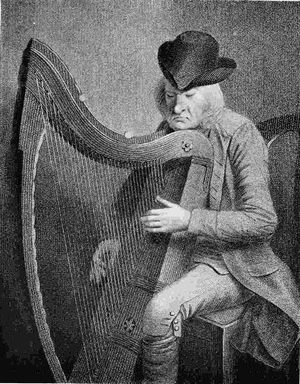Annotation:I Am Asleep and Don't Waken Me (2)
X:1 T:I am sleeping T:I am asleep and don't waken me [2] M:3/4 L:1/8 R:Air B:Samuel, Anne & Peter Thompson - The Hibernian Muse (London, 1787, No. 50) N:"A Collection of the most Favorite Compositions of Carolan the Celebrated Irish Bard" Z:AK/Fiddler's Companion K:G V:1 clef=treble name="2." [V:1]D2|E2G2 (G/A/G)|G4 B2|TA3 GAB|E4 D2|E2G2G2|Bc d2 G2| TA4 GAB|G4 AB|c2 (dc)(BA)|B2 (cB)(AG)|A3 GAB|E4 D2| EF G2G2|Bc d2 G2|A3 GAB|G4||de|f4 fg|(e3d)B2| d2e2 ga|(g3ed2)|Tf4 fg|e2d2B2|(d>ed)BAB|(G3E)D2|f3 efg| efed (e/d/B)|(d3BA2)|(G>AGE)D2|E2G2G2|Bc d2 e2|B3 A (B/A/G)|G6||
I AM ASLEEP AND DON'T WAKEN ME [2] ("Taim I mo chodhladh is na duisigh me," "Táimse im/mo chodladh" or "Ta me mo chodladh"). AKA and see “Cold Frosty Morning (2),” "Lament of a Druid,” "Past One O'Clock," "Thamama Hulla" (an Englished version of the Irish title). Irish, Air (3/4 time). G Major (Thompson): G Mixolydian (Roche, Tubridy): F Major (O’Sullivan/Bunting): F Mixolydian (Stanford/Petrie): D Major/A Mixolydian (Cranitch). Standard tuning (fiddle). AB (O’Sullivan/Bunting): AAB (Stanford/Petrie). A variant of version #1. The first printing of the tune in Ireland was in John and William Neale’s Collection of the Most Celebrated Irish Tunes (Dublin, date of publication usually given as 1721 or 1726, although 1742 is the date Bonnie Shaljean gives in the Appendix to the 2001 edition of O’Sullivan’s Carolan: Life and Times; this based on watermark analysis), the first collection of Irish melodies (Ó Canainn, 1978). As with some other airs, it is unclear whether original provenance lies in Scotland or Ireland, as the melody appears in publications around the same time: if the earlier date for the Neale’s publication is correct, then it predates the Scots appearance in Alexander Stuart's Musick for Allan Ramsay's Collection, c. 1725/6 (where it is given as "Chami ma chattle"). However, there is a parallel in Scottish/English tradition (see note for "Cold Frosty Morning"). It was used in ballad operas of the 18th century (such as Flora, 1737) and is still quite common in the tradition. Cowdery (1990) identifies this tune as a member of "The Blackbird" family. See also the Scottish "Jeanie's Black E'e."
A story is told by O'Neill regarding this tune, quoted in O'Sullivan (1983):
When at Mr. Macdonnell's of Knochranty in the county of Roscommon, he met a young nobleman from Germany who had come to Ireland to look after some property to which he had a claim through his mother. "He was one of the most finished and accomplished young gentlemen," says O'Neill, "that I ever met. When on one occasion Hugh O'Neill and I played our last tunes for him, he wished to call for 'Past one o'clock,' or 'Tha me mo chodladh, naar dhoesk a me,' which he had heard played somewhere before, but for the name he was at a loss. Perceiving me going towards the door, he followed me, and said that the name of his bootmaker was Tommy McCullagh, and that the tune he wanted was like saying 'Tommy McCullagh made boots for me;' and in the broad way he pronounced it, it was not unlike the Irish name. I went in with him and played it, on which he seemed uncommonly happy.
Blind harper Arthur O’Neill (1734–1818), originally from County Tyrone, mentioned the tune (as “Past One O'Clock”) in his memoirs. As a young man he stayed seven years with a Colonel White of Red Hill, County Cavan, and visited his neighbor, a Mr. Norris Thompson, every Saturday night:
I spent my time very pleasantly between Colonel White and Mr. Thompson. I spent one Saturday night with Mr. Thompson particularly and he was so uncommon fond of the tune ‘Past one o’clock’ that we both tête-à-tête finished four bottles of good old port wine, I playing the tune all the time except when lifting my hand to my head.
The Gaelic song “Táimse im’chodladh” is an allegorical lyric, with a beautiful lady personifying Ireland appearing to the writer in a vision, beseeching him to arise and take arms against the invader. It thus falls in the Asiling, or ‘vision’, tradition of Irish poetry and song. It has been asserted that it was composed in the 18th century in Munster. A translation by Dr. Eoin O’Neill of the Irish lyric, goes:
As I was abroad late one evening
-I am asleep and don't waken me-
It happened that I noticed by my side a beautiful apparition
-I am asleep and don't waken me-
Her curly, ringleted, cascading surplus of tresses fell over her trembling limbs,
As she launched the arrows that pierced me in the side.
-I am sleep and don't waken me-
Arise my loyal family and take up your weapons
-I am asleep and don't waken me-
And level to the ground every English clown.
-I am asleep and don't waken me-
If only three survive, let there be shouts of triumph in all your towns;
From Carrick-on-Suir west to the banks of Dingle
Raise your blades and give the English their own treachery;
-I am asleep and don't waken me-
The melody was a part of the old Irish harp tradition, and was also absorbed into piping tradition. County Leitrim piper and fiddler Stephen Grier (1824-1894) included the air in Book 3 of his large c. 1883 music manuscript collection. Piper Brian McNamara (2004) calls it one “of the great airs associated with the Uilleann pipes.” For Scottish versions of the air, see "I Am Asleep and Don't Waken Me (1). See also note for "Past One O'Clock" for more information, particularly regarding the melody in Scotland.

- ↑ Bunting, Ancient Irish Music, 1840, Preface p. 3

